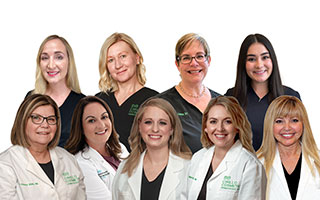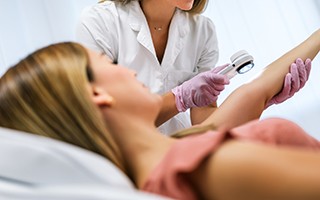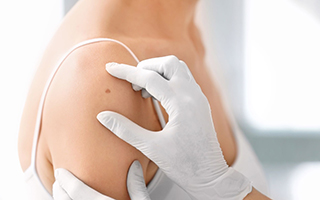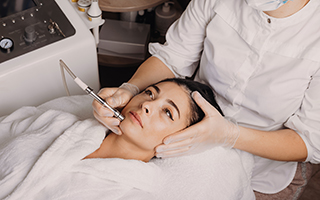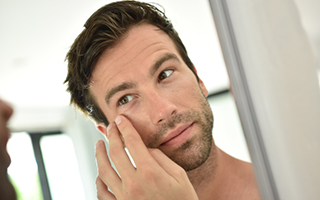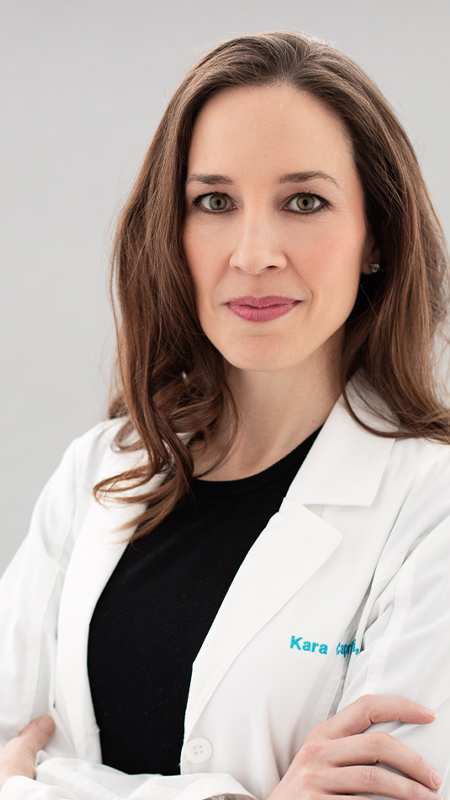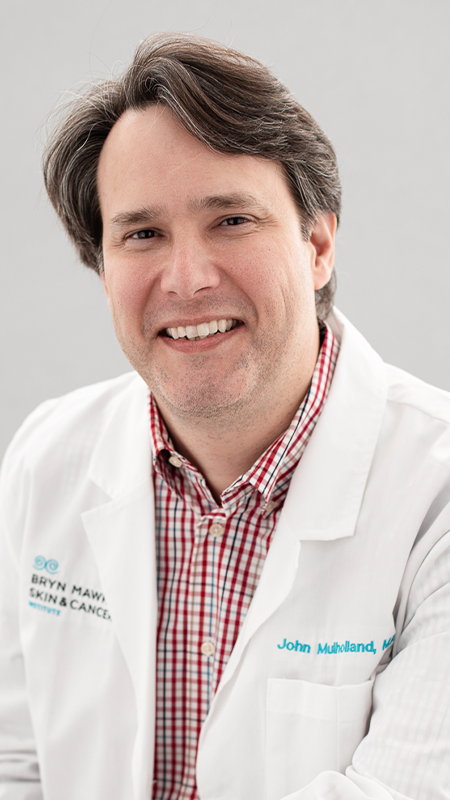Mohs Surgery
The Most Effective Technique for Treating Common Skin Cancers in Bryn Mawr, Newtown Square, Philadelphia, and the Main Line
- Home
- Medical Dermatology
- SKIN CANCER
- Mohs Surgery
Mohs surgery is the technical name for the most effective treatment of most types of skin cancer. Originally developed by Dr. Frederick Mohs in the 1930s, Mohs surgery at The Bryn Mawr Skin & Cancer Institute is used to identify and remove an entire tumor while leaving the greatest amount of surrounding healthy tissue unharmed.
Skin cancers are the most common malignant tumors in fair-skinned individuals. Although some types of these cancers, such as malignant melanoma, can be very serious, the more common forms of skin cancer do not often pose a major threat to a patient’s overall health. Most skin cancers can be detected early by your dermatologist and thus can be safely and effectively treated with a variety of techniques.
Even common skin cancers can be more difficult to treat if they are larger than average size, have a high-risk pathology type, or are recurrent. The board-certified dermatologists at Bryn Mawr Skin & Cancer Institute have been trained to treat these higher-risk skin cancers.
Contact Bryn Mawr Skin & Cancer Institute today to learn whether Mohs surgery is the right treatment for your skin cancer. Contact us online or phone 610.525.0500 for an appointment.
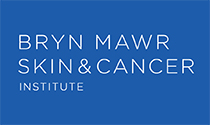
Meet Our Mohs Surgeons
Kara D. Capriotti, M.D. and John K. Mulholland, M.D. perform Mohs Micrographic Surgery for the treatment of skin cancers. Mohs is a specialized surgery technique that maximizes skin cancer cure rates while minimizing removal of healthy tissue surrounding the cancer. Superior outcomes are achieved with this “tissue-sparing” technique.
How Does Mohs Surgery Work?
Mohs micrographic surgery is an outpatient surgical procedure that removes skin cancer cells with the targeted area given local anesthesia. Mohs uses a very precise technique in which small layers of skin are removed and examined under a microscope. If there are no cancer cells visible, on any edge of the sample—known as the margins—then the process stops. If more cancer cells are seen under the microscope after the first skin layer or “level” has been removed, another skin layer is removed and examined. Each “level” is removed until all of the margins in a skin sample are cleared of cancer and no additional levels need to be taken.
By removing only tissue where cancer is present, the technique combines a very high cure rate with assurance that the maximum possible amount of healthy tissue will remain intact. Once the cancer has been entirely removed, the skin defect will be surgically repaired.
Dermatologists who perform Mohs surgery are extensively educated and trained in the specialized technique, as it differs from routine surgical excisions.
How Effective is Mohs Surgery?
Mohs is a very specialized technique because the entire edge and undersurface of each skin cancer layer is carefully examined under the microscope for the presence of cancer cells during your visit. With traditional surgical excision, approximately 1 to 3 percent of the tumor margins are actually examined, thereby increasing the chance that some cancer cells may be left behind.
Mohs surgery allows for examination of 100 percent of the tumor margins, thereby reducing the chance that tumor cells will be left behind. Clinical studies conducted at various national and international medical institutions demonstrate that with a cure rate of 95 to 99 percent, Mohs surgery has the highest cure rate for basal cell and squamous cell carcinomas.
Mohs surgery patients will be encouraged to return for follow-up visits with a dermatologist so their skin can be routinely monitored for any new signs of the cancer returning.
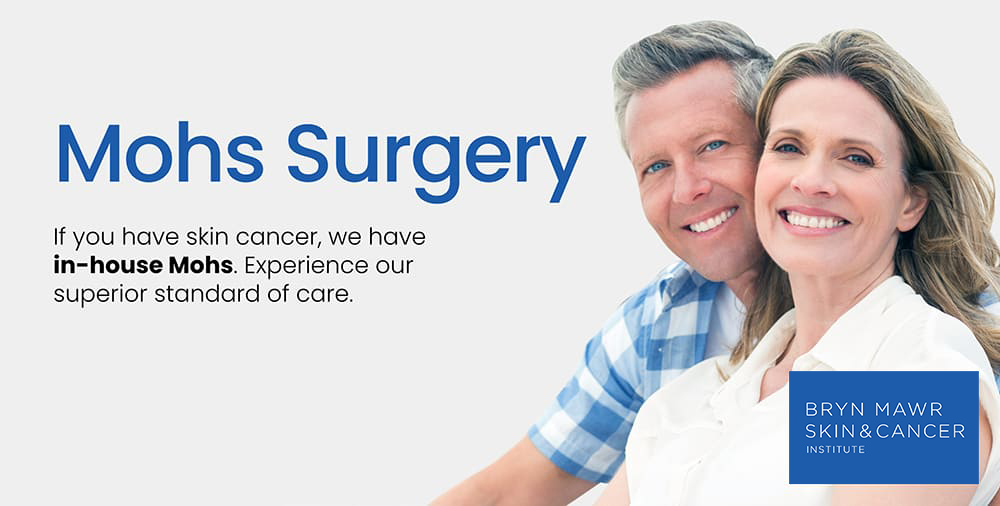
Who is a Good Candidate for Mohs Surgery?
Because of its precision and normal-tissue-sparing properties, Mohs surgery is particularly ideal for patients who have a skin cancer that is in a visible place (such as the face, scalp, neck, hands) or that has a tendency to recur (such as the ears). The fact that it leaves the smallest wound possible makes it a procedure of choice for patients who are looking to minimize scarring without sacrificing effectiveness. The simple, yet elegant process of examining each sample under a microscope for the presence of any cancer cells allows for removal of the total malignancy while leaving healthy intact tissue unharmed. Other, less-precise excision methods have a greater tendency to leave behind cancer cells—and even just a few remaining in the skin can be enough to spread. Mohs surgery is most commonly used to treat basal and squamous cell carcinomas.
The dermatologist will review each patient’s case in order to determine whether Mohs is the best option. Factors to consider include the location of the lesion on the body, the size of the lesion, the type of skin cancer present, the microscopic pathology report, and possible causes of the cancer (such as prior radiation to the area). The physician will also weigh the patient’s age, current state of health, and medical history, including immunosuppression, genetics, and history with cancer, in order to determine if Mohs is the treatment of choice.
What Does Mohs Surgery Cost?
In order for Mohs surgery to be approved by your insurance company, specific criteria must be met. For example, the location of the cancer, its type and size, its microscopic characteristics, and previous therapies are all considered.
Final Words on Mohs Surgery
While Mohs surgery remains an incredibly effective treatment for skin cancer, prevention remains the best strategy for reducing risk. Always wear sunscreen, a hat, sunglasses, and UV-protective clothing when outdoors in order to minimize exposure to ultraviolet radiation, which is the most important risk factor for the development of skin cancer.
Early detection is the most important factor in the successful treatment of skin cancer. Schedule regular check-ups with a dermatologist who can thoroughly examine your skin and perform biopsies if any suspicious lesions are identified. The earlier a skin cancer is found, the better the cure rate.
Why Choose the Bryn Mawr Skin & Cancer Institute?
As part of The Cirillo Institute, The Bryn Mawr Skin & Cancer Institute was founded by board-certified dermatologists Drs. Chalmers Cornelius and Victoria Cirillo-Hyland, who have built a highly credentialed and experienced team of fellow dermatologists to treat all skin conditions. In addition to skin cancer, the institute offers solutions for patients dealing with acne, as well as the chronic skin conditions of eczema, psoriasis, and rosacea.
Bryn Mawr Skin & Cancer Institute also has its own dermatopathologist, Dr. John Mulholland, who examines skin biopsies under the microscope and renders a diagnosis based on the results.
Dr. Cirillo-Hyland’s goal is to provide a full range of medical, surgical, and cosmetic services in order to give patients the most advanced options for treating every skin condition.
Find out whether Mohs Surgery is the most effective technique for your skin cancer by contacting Bryn Mawr Skin & Cancer Institute today. To schedule an appointment, Please BOOK ONLINE, call 610.525.5028, or Contact Us.


